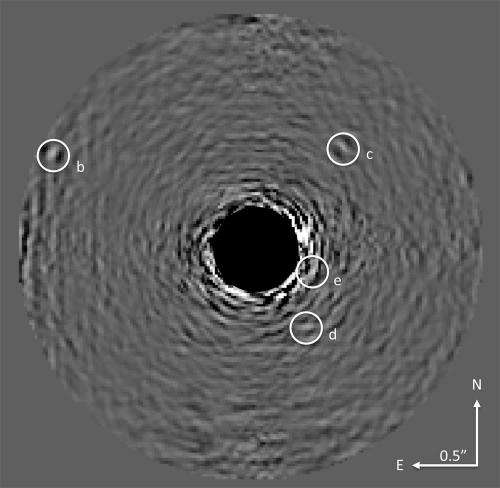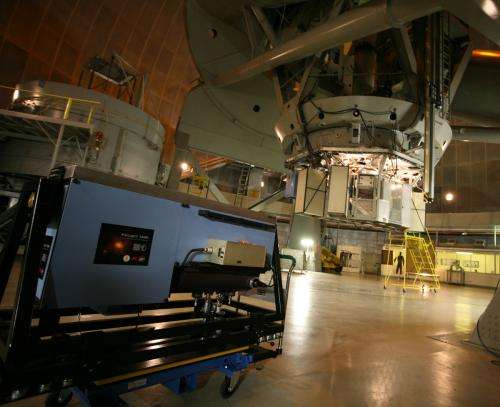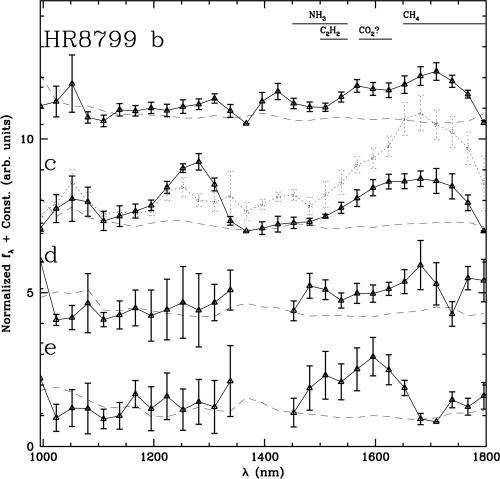It looks like you're using an Ad Blocker.
Please white-list or disable AboveTopSecret.com in your ad-blocking tool.
Thank you.
Some features of ATS will be disabled while you continue to use an ad-blocker.
share:
This is one of the first success of the
project 1640 with a direct image of HR
8799 planetary system, which is 128 light years away from Earth:

This image of the HR 8799 planets was taken with starlight optically suppressed and data processing conducted to remove residual starlight. The star is at the center of the blackened circle in the image. The four spots indicated with the letters b through e are the planets. This is a composite image using 30 wavelengths of light and was obtained over a period of 1.25 hours on June 14 and 15, 2012. Credit: Project 1640

This photo shows the Project 1640 instrument in the telescope dome of the 200-inch Hale Telescope at Palomar Observatory, prior to being installed for observations. Credit: Palomar Observatory/S. Kardel
This research sounds very promising, as the spectroscopy signature tools of project 1640 will be now able to show the complete spectra of exoplanets:

This graph shows the spectra of all four planets orbiting HR 8799. The plot shows how bright each object is (y-axis) versus the wavelength of light or color measured. Dips and peaks in these plots are due to the presence or absence of certain molecules (indicated at the top of the plot). Credit: Project 1640
During its three-year survey at Palomar, which started in June 2012, Project 1640 aims to survey 200 stars within about 150 light years of our solar system.
Maybe spectral signature of one of these planetary systems will be similar to that of the Earth? Fantastic news anyway, and a great step forward for the exoplanet life hunting!
Read the whole article at: phys.org

This image of the HR 8799 planets was taken with starlight optically suppressed and data processing conducted to remove residual starlight. The star is at the center of the blackened circle in the image. The four spots indicated with the letters b through e are the planets. This is a composite image using 30 wavelengths of light and was obtained over a period of 1.25 hours on June 14 and 15, 2012. Credit: Project 1640
Researchers have conducted a remote reconnaissance of a distant solar system with a new telescope imaging system that sifts through the blinding light of stars. Using a suite of high-tech instrumentation and software called Project 1640, the scientists collected the first chemical fingerprints, or spectra, of this system's four red exoplanets, which orbit a star 128 light years away from Earth. A detailed description of the planets—showing how drastically different they are from the known worlds in the universe—was accepted Friday for publication in The Astrophysical Journal.

This photo shows the Project 1640 instrument in the telescope dome of the 200-inch Hale Telescope at Palomar Observatory, prior to being installed for observations. Credit: Palomar Observatory/S. Kardel
This research sounds very promising, as the spectroscopy signature tools of project 1640 will be now able to show the complete spectra of exoplanets:
"Now, with Project 1640, we are beginning to turn this tool to the investigation of neighboring exoplanets to learn about the composition, temperature, and other characteristics of their atmospheres." said Charles Beichman, executive director of the NASA Exoplanet Science Institute at the California Institute of Technology.

This graph shows the spectra of all four planets orbiting HR 8799. The plot shows how bright each object is (y-axis) versus the wavelength of light or color measured. Dips and peaks in these plots are due to the presence or absence of certain molecules (indicated at the top of the plot). Credit: Project 1640
The results are "quite strange," Oppenheimer said. "These warm, red planets are unlike any other known object in our universe. All four planets have different spectra, and all four are peculiar. The theorists have a lot of work to do now."
"The spectra of these four worlds clearly show that they are far too toxic and hot to sustain life as we know it," said co-author Ian Parry, a senior lecturer at the Institute of Astronomy, Cambridge University. "But the really exciting thing is that one day, the techniques we've developed will give us our first secure evidence of the existence of life on a planet outside our solar system." In addition to revealing unique planets, the research debuts a new capability to observe and rapidly characterize exoplanetary systems in a routine manner, something that has eluded astronomers until now because the light that stars emit is tens of millions to billions of times brighter than the light given off by planets. This makes directly imaging and analyzing exoplanets extremely difficult: as Oppenheimer says, "It's like taking a single picture of the Empire State Building from an airplane that reveals the height of the building as well as taking a picture of a bump on the sidewalk next to it that is as high as a couple of bacteria."
During its three-year survey at Palomar, which started in June 2012, Project 1640 aims to survey 200 stars within about 150 light years of our solar system.
Maybe spectral signature of one of these planetary systems will be similar to that of the Earth? Fantastic news anyway, and a great step forward for the exoplanet life hunting!
Read the whole article at: phys.org
edit on 12-3-2013 by
elevenaugust because: (no reason given)
Finally something worth giving a flag.
Great find, for both you and the scientist
Can't wait for more info on this and future project.
Great find, for both you and the scientist
Can't wait for more info on this and future project.
edit on 12-3-2013 by Mianeye because: (no reason given)
My god, to look back in time into another solar system is just so mind bogglingly incredible. I shudder with excitement to think how the optic
quality and technology will progress over the next 50 years, I better live to 90 odd, cause by them it will probably be on google maps!
Edit (As usual, another incredibly interesting discovery brought to us by Elevenaugust! The amount of time you put in does not go unoticed by me, ATS put this man on payroll!!! )
Edit (As usual, another incredibly interesting discovery brought to us by Elevenaugust! The amount of time you put in does not go unoticed by me, ATS put this man on payroll!!! )
edit on 12-3-2013 by Qumulys because: (no reason given)
Originally posted by samuel1990
reply to post by elevenaugust
3 year survey that started in June 2012?
WHAT YEAR IS IT.....?!?! :O
It's 2013. Which means it has not completed yet.
Why was that .. even.. nevermind...
Originally posted by samuel1990
reply to post by elevenaugust
3 year survey that started in June 2012?
WHAT YEAR IS IT.....?!?! :O
DOH!!!
Awesome!
Thanks for sharing, and I can't wait to see other results from their survey!
Thanks for sharing, and I can't wait to see other results from their survey!
If the star at the center of the black dot fills much of it then the planets seem very close to their sun. Or is the star just a very tiny portion of
the black dot, which had to be larger to block out the excess starlight?
edit on 12-3-2013 by Aleister because: (no reason given)
awesomely fascinating, thank you for sharing.
it's interesting to think that by the end of the survey they may perhaps have traced more distant planets going around that star. maybe some moons too
the conclusions they may draw when they have finished analysing the light make me itch too!
i'm off to read the full article now, SnF most obviously
it's interesting to think that by the end of the survey they may perhaps have traced more distant planets going around that star. maybe some moons too
the conclusions they may draw when they have finished analysing the light make me itch too!
i'm off to read the full article now, SnF most obviously
reply to post by Aleister
The star is just a very tiny portion of the black dot, which had to be larger to block out the excess starlight.
The star is just a very tiny portion of the black dot, which had to be larger to block out the excess starlight.
Wonderful.
A giant leap for mankind.
S&F
Thanks for posting OP.
A giant leap for mankind.
S&F
Thanks for posting OP.
"The theorists have a lot of work to do now."
Whether this actually is direct observation of planets is debatable. So much data was manipulated to try to show what they were after means you could present it as just about anything you wish.
Whether this actually is direct observation of planets is debatable. So much data was manipulated to try to show what they were after means you could present it as just about anything you wish.
Wow! Thank you so much for sharing this. It's absolutely incredible to think that we're effectively looking back in time. Of course, we're looking
back in time eight minutes when we look at the Sun (which we shouldn't!) but the scale of this is so much larger. I think it's amazing that we can
stare into the Universe's past.
Finally, an actual image of an exoplanet.
This, combined with recent news that Mars could indeed have supported life, makes me suspect we're being fed information that was already known.
Who wants to bet we're going to find microbial life on Mars in the next 5 years? They probably already have found it, but they'll re-find it when they think we're conditioned enough to accept it.
This, combined with recent news that Mars could indeed have supported life, makes me suspect we're being fed information that was already known.
Who wants to bet we're going to find microbial life on Mars in the next 5 years? They probably already have found it, but they'll re-find it when they think we're conditioned enough to accept it.
One thing why are they calling it another solar system? our star is called "Sol" hence "solar system" this should be called the "HR 8799 system"
just nitpicking...
reply to post by elevenaugust
Cool, Let me know when they find one with evidence of chemtrails, smog and radioactivity...
This research sounds very promising, as the spectroscopy signature tools of project 1640 will be now able to show the complete spectra of exoplanets:
Cool, Let me know when they find one with evidence of chemtrails, smog and radioactivity...
Excellent find. Thanks for posting!
I can't help wondering if they missed a couple of planets - if you look along the outside edge of the circle, at 12 o'clock and 2:30 there are very similar looking "objects" to those planets indicated by the small white circles. I guess those must have been ruled out though?!
I can't help wondering if they missed a couple of planets - if you look along the outside edge of the circle, at 12 o'clock and 2:30 there are very similar looking "objects" to those planets indicated by the small white circles. I guess those must have been ruled out though?!
new topics
-
Trump picks Gov. Kristi Noem to serve as homeland security secretary
2024 Elections: 3 hours ago -
Elon's Starlink Stole The Election For Trump--Leftist Conspiracy Theorists Charge
General Conspiracies: 6 hours ago -
Speaker Johnson Orders Entire Biden Administration to Preserve and Retain All Records - Documents
US Political Madness: 7 hours ago -
Resident Plane enthusiasts needed weird noise
General Chit Chat: 10 hours ago
top topics
-
Fired FEMA Employee Says It Was Not ‘Isolated’ Incident: ‘Colossal Event Of Avoidance’
US Political Madness: 12 hours ago, 25 flags -
Speaker Johnson Orders Entire Biden Administration to Preserve and Retain All Records - Documents
US Political Madness: 7 hours ago, 17 flags -
Elon's Starlink Stole The Election For Trump--Leftist Conspiracy Theorists Charge
General Conspiracies: 6 hours ago, 16 flags -
Trump picks Gov. Kristi Noem to serve as homeland security secretary
2024 Elections: 3 hours ago, 11 flags -
Australia has been holding out on us
Music: 13 hours ago, 4 flags -
Resident Plane enthusiasts needed weird noise
General Chit Chat: 10 hours ago, 4 flags
active topics
-
President-Elect DONALD TRUMP's 2nd-Term Administration Takes Shape.
Political Ideology • 133 • : WeMustCare -
Otherworldly wreckage found on Mars…
Space Exploration • 36 • : JJproductions -
Elon's Starlink Stole The Election For Trump--Leftist Conspiracy Theorists Charge
General Conspiracies • 26 • : Dalamax -
Speaker Johnson Orders Entire Biden Administration to Preserve and Retain All Records - Documents
US Political Madness • 22 • : Dalamax -
President-Elect Donald Trump will Meet with Coup-Victim JOE BIDEN on Wed 11.13.2024.
2024 Elections • 18 • : WeMustCare -
Diddy Arrested in NYC After Grand Jury Indictment
Other Current Events • 16 • : WeMustCare -
Trump picks Gov. Kristi Noem to serve as homeland security secretary
2024 Elections • 12 • : WeMustCare -
Australia has been holding out on us
Music • 5 • : Dalamax -
Your Opinion ... 2nd assassination attempt ... the shooter was a ... ????
Political Conspiracies • 277 • : Therealbeverage -
Will Biden Step Down
US Political Madness • 48 • : Therealbeverage
